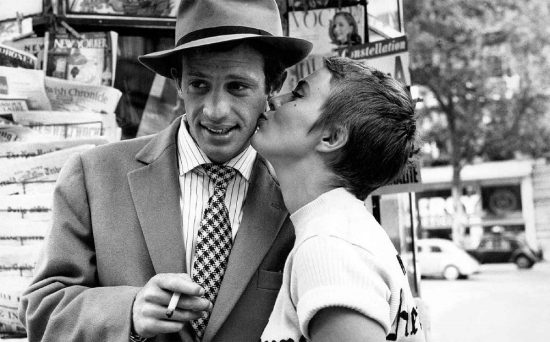Late To The Party: À bout de souffle – “Effortlessly cool and stylish”
Late To The Party is a series of reviews ranging from classical masterpieces to modern-day blockbusters where I look to make my confession for the sin of not having seen them before. I seek absolution from the film universe and hope to never again suffer your disdain for my film faux pas. I am Fredo, in the boat. Hail Mary, full of grace.
Jean-Luc Goddard’s 1960 À bout de souffle or Breathless stars Jean-Paul Belmondo and Jean Seberg. It follows the story of small-time crook, Michel (Belmond). After stealing a car in Marseilles, Michel is pursued by traffic police on his way to Paris. He eventually pulls over and murders one of the policemen. Abandoning the car, he goes on the run, and when in Paris, he reunites with one-time girlfriend and American journalism student, Patricia (Seberg). He attempts to persuade Patricia to run away with him to Rome, as he tries to follow up on money that is owed to him to fund his escape. In the meantime, the police are closing in on Michel, as Inspector Vital (played by Daniel Boulanger) doggedly tracks him down.
The film was one of the most influential examples of the French New Wave of cinema. A movement of filmmakers who emerged from a post-war France and sought to rebel against what was perceived as the predictable and tired Hollywood way of making films. They broke traditions of narrative, editing and filming techniques, partly out of financial and practical necessity but also in an attempt to further their artistic vision and expression. These new filmmakers saw cinema being as artistically valid as literature or painting and the perfect vehicle for what they wanted to express. Not being constrained by the accepted cinematic conventions at the time, these filmmakers experimented with long, single-shot takes, existential themes, jump cuts and raising questions that would not always be answered or tied-off, come the end of the film.
The movement also helped to usher in a new generation of anti-hero. Michel, the film’s main character is a nihilistic sociopath, who thinks nothing of murdering a police officer, stealing from a friend or beating up a stranger in a toilet to take their money. Yet, the film goes to great lengths to show the character modelling himself on Humphrey Bogart, Hollywood’s hero at the time. Michel sees himself as the hero of his own story, in stark contrast to society’s opinion of him, as demonstrated by newspaper headlines declaring him to be a murderer and a monster. The film paints him as the epitome of style from the opening shot of him, stylish sunglasses, a Gauloises cigarette hanging from his mouth and wearing his hat at a dis-interested angle. The swagger is effortless and the Baby Boomer generation had its first iconic anti-hero.
But for all of the New Wave’s anti-Hollywood ethos, it is no coincidence that the leading lady is American. Patricia is a journalism student, an American in Paris, having grown up in New York. In America, she would very much be a part of the Beat Generation. The New Wave shares common ground with the Beat Generation in attitudes to established artistic form and ushering in a new era for youthful artistic expression. For all of its rejection of the established traditions of art and film, the admiration for Bogart’s and Cagney’s Hollywood is there for all to see.
Much like the new improvisational Jazz of the time, the film has a syncopated beat to it. It has several long, one-shot takes in apartments where the character’s dialogue moves from plot-related themes to abstract existentialism in a single breath. The pace then shifts to scenes involving discussions of art and sexual politics where sections of dialogue are cut crudely, giving a jarring, yet focused effect. Goddard wants to wake his audience up from their comfortable slumber. These films were made to challenge and question, as opposed to what the New Wave saw as comfortable and easy subjects with comfortable and easy approaches to filming.
À bout de souffle and its contemporaries were a major influence on many films and filmmakers. Most notably in Arthur Penn’s 1967 Bonnie And Clyde, the sense of style and nihilism is uncanny. Its influence can also be seen in the films of Quentin Tarantino in the long, self-indulgent dialogue-heavy scenes. Tarantino’s production company, A Band Apart is a play on the name of another New Wave film, Bande a part. There was also an influence or at least common ground shared with the British New Wave of films known as the Kitchen Sink Dramas such as Look Back In Anger, This Sporting Life and Saturday Night, Sunday Morning. These films also ushered in a new generation of filmmaker and actor. In terms of film making techniques, the French New Wave was an obvious influence on the Dogme 95 Manifesto filmmakers. They were also a great influence on the films of the American independent filmmaker, John Cassavetes.
À bout de souffle or Breathless as it is known in English, still comes across as effortlessly cool and stylish. Sixty years after its release, it feels fresh and new, which probably says as much about the mainstream cinema of today as it does about this film.










